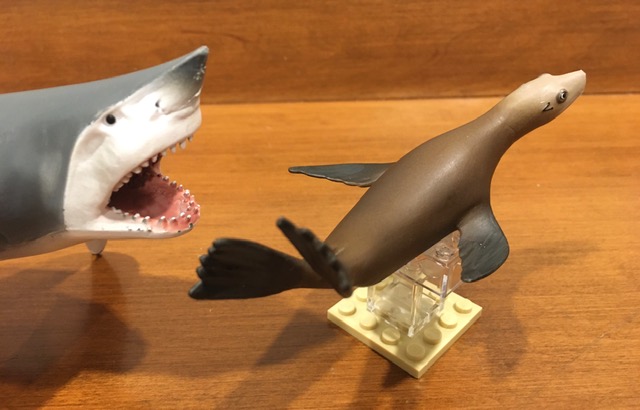Review and images by Suspsy; edited by bmathison1972
The California sea lion (Zalophus californianus) is perhaps the most familiar of all the eared seals due to its popularity in zoos and aquariums as well as its range across most of the western coastline of North America. Intelligent and adaptable, it is just as comfortable resting on a man-made structure, such as the famous Pier 39 in San Francisco, as it is on a remote sandy beach.

The Wild Safari Sealife California sea lion was released back in 2007. It is sculpted in an active swimming pose with its body turning to the right, its front flippers swept back, and its back arched. This makes it about 11 cm (4.3”) long and 6 cm (2.4”) wide at the flipper tips. It’s a nice active pose, but it means that the toy ends up tilted to one side and resting on its right flipper. Hence my improved LEGO display stand. Incidentally, one of the major differences between sea lions and true seals is that the former use their front flippers to propel themselves through the water and their hind flippers to steer. By contrast, true seals use their hind flippers for propulsion and their front flippers for steering.

The main colour on this toy is dark brown with darker brown for the flippers and very light brown for the head. Black is used for the nose and ears and the black and white eyes are ringed with dark brown. The relatively streamlined shape of the head and the thin neck suggests that this individual is a female. Males, in addition to being bigger, have thicker necks and prominent sagittal crests that give the appearance of domed foreheads. A female like this one would average around 100 kg (220 lbs) in weight.

Perhaps to the disappointment of some, sculpting detail on this sea lion is about as basic as a Safari Ltd. toy can be. The flippers have a ribbed texture, and the head features raised orbits and some tiny pits around the muzzle, but aside from that, the body is completely smooth. Even the ears appear to have been painted on.

On a more positive note, this appears to be quite an accurate toy in terms of anatomy. Combined with the dynamic pose and alert-looking eyes, it gives off the appearance of a swift and agile swimmer. Like other members of its family, the California sea lion feeds primarily on squid and various fish including herring, salmon, and dogfish. It is in turn preyed upon by the great white shark and the killer whale.

While the relative lack of sculpted detail on this toy is unfortunate, it is still a pleasing and fun little pinniped. Perhaps Safari Ltd. will release an improved version in the future. In the mean time, you should be able to find this sea lion for sale at various online retailers if not in stores.
Disclaimer: links to Ebay and Amazon on the AnimalToyBlog are affiliate links, so we make a small commission if you use them. Thanks for supporting us!




You know, I never cared for this figure. I always thought it looked too stylized, and quite atypical for most Safari figures. A lot of brands have a ‘style’ or ‘look’ to them, and this looks quite unlike any other Safari figures.
On a plus, I learned something interesting in the differences between true and eared seals with regards to how they swim, in being the opposite of which flippers are used for swimming vs. steering. One of the reasons I collect toy animals is to continually learn about the actual animals!
I chose it in part because it is specifically a California sea lion as opposed to simply being billed as “sea lion.”
You know, I contemplated it for that very reason. But in the end, the morphology of the CollectA figure won out (although I have it databased as a California sea lion)